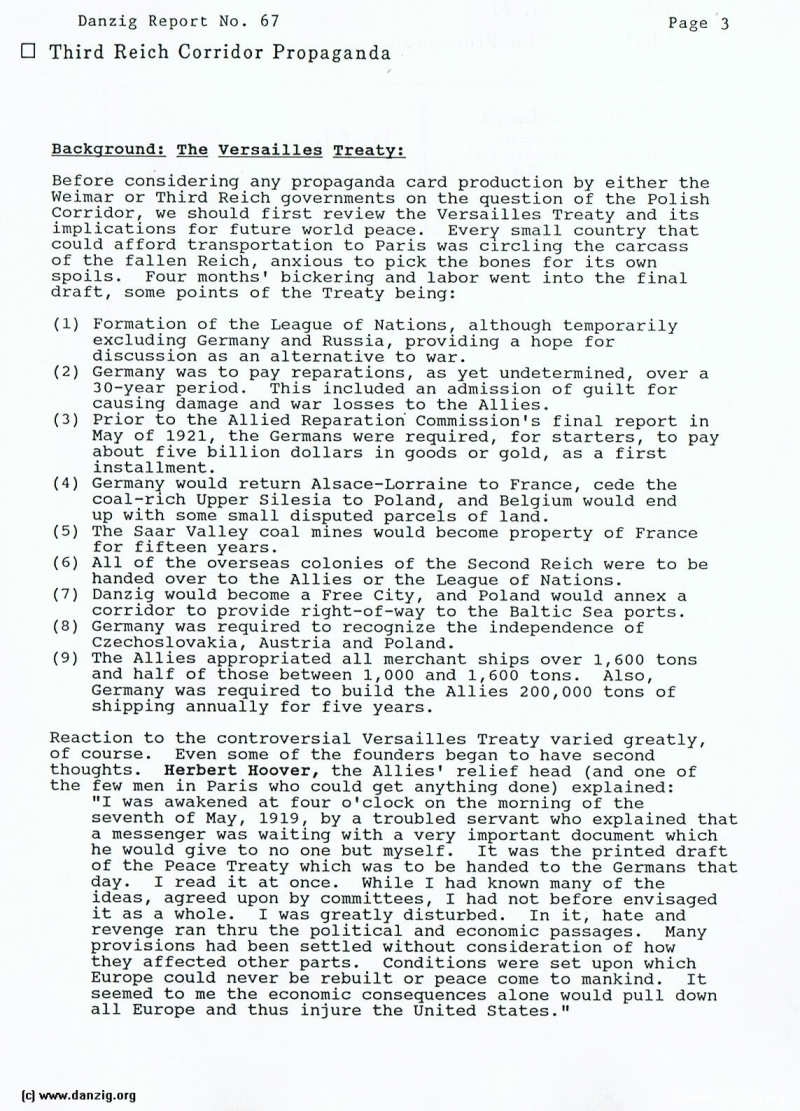
Third Reich Corridor Propaganda
Background: The Versailles Treaty:
Before considering any propaganda card production by either the Weimar or Third Reich governments on the question of the Polish Corridor, we should first review the Versailles Treaty and its implications for future world peace. Every small country that could afford transportation to Paris was circling the carcass of the fallen Reich, anxious to pick the bones for its own spoils. Four months’ bickering and labor went into the final draft, some points of the Treaty being:
(1) Formation of the League of Nations, although temporarily excluding Germany and Russia, providing a hope for discussion as an alternative to war.
(2) Germany was to pay reparations, as yet undetermined, over a 30—year period. This included an admission of guilt for causing damage and war losses to the Allies.
(3) Prior to the Allied Reparation Commission’s final report in May of 1921, the Germans were required, for starters, to pay about five billion dollars in goods or gold, as a first installment.
(4) Germany would return Alsace-Lorraine to France, cede the coal—rich Upper Silesia to Poland, and Belgium would end up with some small disputed parcels of land.
(5) The Saar Valley coal mines would become property of France for fifteen years.
(6) All of the overseas colonies of the Second Reich were to be handed over to the Allies or the League of Nations.
(7) Danzig would become a Free City, and Poland would annex a corridor to provide right-of-way to the Baltic Sea ports.
(8) Germany was required to recognize the independence of Czechoslovakia, Austria and Poland.
(9) The Allies appropriated all merchant ships over 1,600 tons and half of those between 1,000 and 1,600 tons. Also, Germany was required to build the Allies 200,000 tons of shipping annually for five years.
Reaction to the controversial Versailles Treaty varied greatly, of course. Even some of the founders began to have second thoughts. Herbert Hoover, the Allies’ relief head (and one of the few men in Paris who could get anything done) explained:
“I was awakened at four o’clock on the morning of the seventh of May, 1919, by a troubled servant who explained that a messenger was waiting with a very important document which he would give to no one but myself. It was the printed draft of the Peace Treaty which was to be handed to the Germans that day. I read it at once. While I had known many of the ideas, agreed upon by committees, I had not before envisaged it as a whole. I was greatly disturbed. In it, hate and revenge ran thru the political and economic passages. Many provisions had been settled without consideration of how they affected other parts. Conditions were set upon which Europe could never be rebuilt or peace come to mankind. It seemed to me the economic consequences alone would pull down all Europe and thus injure the United States.”
Danzig Report Vol. 1 - Nr. 67 - April - May - June - 1990, Page 3.
Hits: 3348
Added: 29/06/2015
Copyright: 2025 Danzig.org

